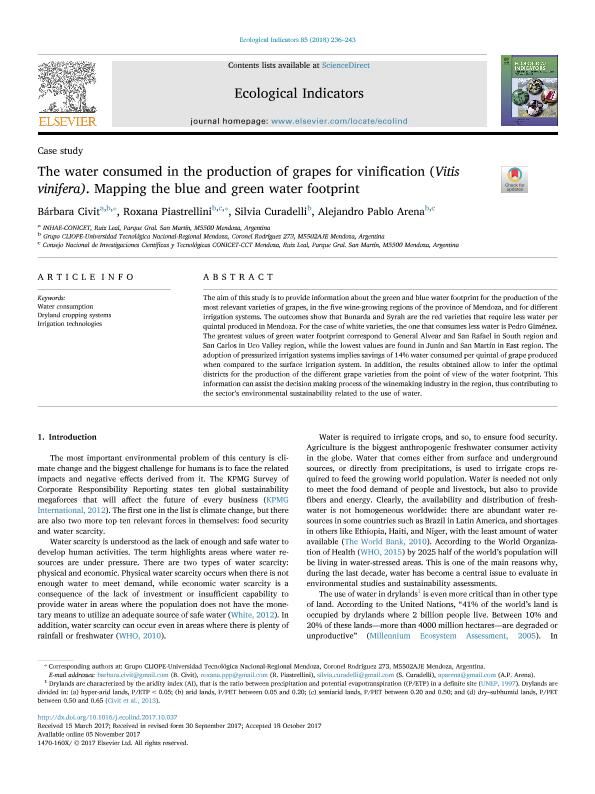Mostrar el registro sencillo del ítem
dc.contributor.author
Civit, Bárbara María

dc.contributor.author
Piastrellini, Roxana

dc.contributor.author
Curadelli, Silvia
dc.contributor.author
Arena, Alejandro Pablo

dc.date.available
2018-04-03T16:22:38Z
dc.date.issued
2018-02
dc.identifier.citation
Civit, Bárbara María; Piastrellini, Roxana; Curadelli, Silvia; Arena, Alejandro Pablo; The water consumed in the production of grapes for vinification ( Vitis vinifera) . Mapping the blue and green water footprint; Elsevier Science; Ecological Indicators; 85; 2-2018; 236-243
dc.identifier.issn
1470-160X
dc.identifier.uri
http://hdl.handle.net/11336/40496
dc.description.abstract
The aim of this study is to provide information about the green and blue water footprint for the production of the most relevant varieties of grapes, in the five wine-growing regions of the province of Mendoza, and for differentirrigation systems. The outcomes show that Bonarda and Syrah are the red varieties that require less water per quintal produced in Mendoza. For the case of white varieties, the one that consumes less water is Pedro Giménez. The greatest values of green water footprint correspond to General Alvear and San Rafael in South region and San Carlos in Uco Valley region, while the lowest values are found in Junín and San Martín in East region. The adoption of pressurized irrigation systems implies savings of 14% water consumed per quintal of grape produced when compared to the surface irrigation system. In addition, the results obtained allow to infer the optimal districts for the production of the different grape varieties from the point of view of the water footprint. This information can assist the decision making process of the winemaking industry in the region, thus contributing to the sector?s environmental sustainability related to the use of water.
dc.format
application/pdf
dc.language.iso
eng
dc.publisher
Elsevier Science

dc.rights
info:eu-repo/semantics/openAccess
dc.rights.uri
https://creativecommons.org/licenses/by-nc-nd/2.5/ar/
dc.subject
Water Consumption
dc.subject
Drylan Cropping System
dc.subject
Irrigation Technologies
dc.subject.classification
Ingeniería Medioambiental y Geológica, Geotécnicas

dc.subject.classification
Ingeniería del Medio Ambiente

dc.subject.classification
INGENIERÍAS Y TECNOLOGÍAS

dc.title
The water consumed in the production of grapes for vinification ( Vitis vinifera) . Mapping the blue and green water footprint
dc.type
info:eu-repo/semantics/article
dc.type
info:ar-repo/semantics/artículo
dc.type
info:eu-repo/semantics/publishedVersion
dc.date.updated
2018-03-27T19:59:37Z
dc.journal.volume
85
dc.journal.pagination
236-243
dc.journal.pais
Países Bajos

dc.journal.ciudad
Amsterdam
dc.description.fil
Fil: Civit, Bárbara María. Consejo Nacional de Investigaciones Científicas y Técnicas. Centro Científico Tecnológico Conicet - Mendoza. Instituto de Ambiente, Hábitat y Energía; Argentina. Universidad Tecnológica Nacional. Facultad Regional Mendoza. Grupo CLIOPE. Energía, Ambiente y Desarrollo Sustentable; Argentina
dc.description.fil
Fil: Piastrellini, Roxana. Universidad Tecnológica Nacional. Facultad Regional Mendoza. Grupo CLIOPE. Energía, Ambiente y Desarrollo Sustentable; Argentina. Consejo Nacional de Investigaciones Científicas y Técnicas. Centro Científico Tecnológico Conicet - Mendoza; Argentina
dc.description.fil
Fil: Curadelli, Silvia. Universidad Tecnológica Nacional. Facultad Regional Mendoza. Grupo CLIOPE. Energía, Ambiente y Desarrollo Sustentable; Argentina
dc.description.fil
Fil: Arena, Alejandro Pablo. Universidad Tecnológica Nacional. Facultad Regional Mendoza. Grupo CLIOPE. Energía, Ambiente y Desarrollo Sustentable; Argentina. Consejo Nacional de Investigaciones Científicas y Técnicas. Centro Científico Tecnológico Conicet - Mendoza; Argentina
dc.journal.title
Ecological Indicators

dc.relation.alternativeid
info:eu-repo/semantics/altIdentifier/url/http://www.sciencedirect.com/science/article/pii/S1470160X1730674X?via%3Dihub
dc.relation.alternativeid
info:eu-repo/semantics/altIdentifier/doi/http://dx.doi.org/10.1016/j.ecolind.2017.10.037
Archivos asociados
